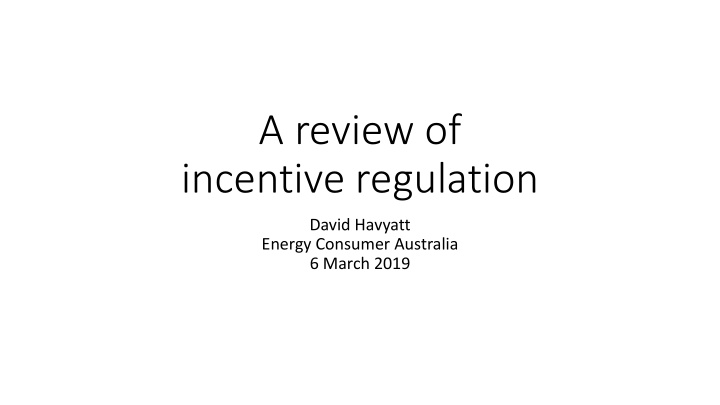



A review of incentive regulation David Havyatt Energy Consumer Australia 6 March 2019
Efficiency • Regulation of natural monopolies for efficient outcomes is a precondition for the promotion of the long term interests of consumers • Allocative efficiency – efficient prices • Productive efficiency – efficient costs
The theory of incentives • Deals with any principal (with objective) and agent (who takes ation). • Two poles • Pure cost of service – efficient prices but because of unknown effort moral hazard in accepting business costs • Fixed price – efficient costs but because of unknown cost opportunities adverse selection in setting the price • Full theory – optimal outcome is a menu of a proportional blend of fixed price and cost of service • Note: it is a fallacy to believe we can measure actual costs because the actual ‘required rate of return on equity’ is unobservable
Incentives in practice • Revenue not price – but ignore for now • A modification of a fixed price regime with five yearly reset and X used for smoothing not as a productivity adjustment • EBSS and CESS are constructs of the method we use to determine revenue. • EBSS deals with the timing in period due to use of year 4. That 30% is ‘retained’ is calculation using 6% discount rate. • CESS deals with timing issue and designed to give the same 30% retention rate. • Different outcomes in retention occurs if WACC 6% • Business faces incentive to ‘build the RAB’ if allowed RoR > actual cost of capital
What do we mean by opex/capex choice • There is no mechanism whereby a network can make a revenue proposal that increases their profit while decreasing consumer prices • It is in preparing the regulatory proposal that the big opex/capex - trade-off decisions are made • The biases in the incentive regime are about biases in where to apply effort in improving efficiency rather than in choosing between opex and capex
ACCC Recommendations • 13 The National Electricity Rules should explicitly allow for a process whereby network assets may be stranded and the costs of that stranding is shared between users and networks. The AEMC should determine the definition of ‘stranding’ and how the costs of ‘stranding’ can be shared • 17 The AEMC should: • as part of its annual network regulatory framework review, examine areas which can reduce the complexity of the existing framework and the time needed to implement changes • in amending any rules, be required to minimise additional complexity in the overall rules framework.
Alternative approaches • Focus on the process of allowed revenue calculation, and not just a how much you spend question. • Harmonise revenue determination periods so we can benchmark on forward costs not backward. • Decide how we want to use benchmarks – do we give everyone an allowance on the average? • Ask fundamental questions – is there some part of network costs that should be covered in land rates. • Reduce the allowed rate of return so it is BELOW the actual cost of capital and use output-incentives/performance-based-regulation as the way that networks recover their actual costs. • Allow networks to work out the balance between the incentives with their customers.
Recommend
More recommend